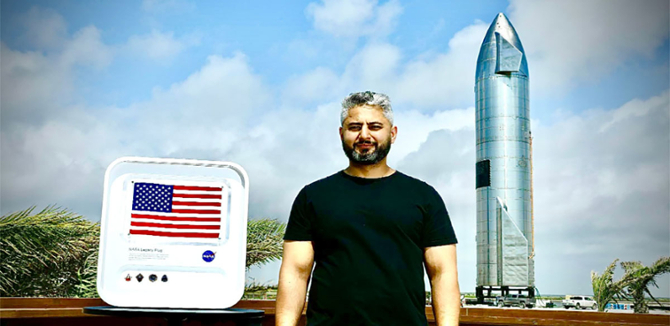Mission: Mars and the Moon
MEM student Usman Rafiq is helping humankind’s latest space exploration efforts.
Usman Rafiq is part of humankind’s quest to reach faraway frontiers.
As a member of Northwestern's Master of Engineering Management (MEM) program, Rafiq is honing the skills he needs to push himself into higher leadership positions to help guide NASA’s drive to return to the moon.
In fact, when the next chapter in the history of space exploration is written, Rafiq might have involvement in not just one but two major accomplishments.
Prior to joining the MEM program in September 2021, Rafiq was an automation and controls designer for SpaceX, the company working to, among other things, send humans to Mars. Rafiq worked on factory automation and engineering for the launch pad systems for Starship, the future-is-now craft that would take space travelers to the red planet.
“Not a single day went by where I did not learn something new or see something fascinating,” Rafiq said of his time with SpaceX. “It was a great place to learn and grow, a place with palpable excitement.”
Rafiq’s SpaceX work enabled the company to produce more of its massive rockets by accelerating the pace of troubleshooting efforts and, in the process, reducing costs and downtime.
He also helped engineer the Integration Tower for Starship that allows for the spacecraft's two parts – a rocket and the capsule that carries astronauts – to be stacked on top of each other for launch and to catch the returning booster after it propels the explorers toward outer space.
“Integration Tower is often called ‘Mechazilla,’” Rafiq said. “It is state-of-the-art engineering, something that had never been done before.”
While he enjoyed his time at SpaceX, Rafiq felt he needed more education to progress into a managerial role. For that, he turned to MEM. The program appealed to him because of its focus on training engineering professionals to develop management skills.
“I do hope to further advance in a management role in the future," he said, "and I am confident to take with me the skills and lessons I have learned from the MEM into any sphere of engineering."
As Rafiq completes MEM's part-time program, he now is building on his SpaceX experiences with a new job at NASA to support Mission Artemis and its efforts to land the first female and first astronaut of color on the moon’s south pole. Rafiq will be building and testing hardware for the mission’s launch system.
If successful, the mission will be the first crewed moon landing in more than half a century.
“The names of the people related to Artemis will go down in American history,” Rafiq said. “It would mean the world to me to be a part of that.”
He is hoping to use the lessons from MEM to secure an even more significant role in this and other future history-making missions.
“The valuable experiences and knowledge learned while being a part of MEM will definitely help me climb the corporate ladder and become a better manager, leader and team player,” he said. “MEM has equipped me with all the skills necessary to lead a successful team and projects.”


